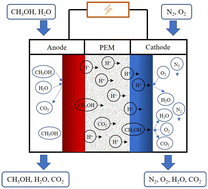Research developments in the application of electrospun nanofibers in direct methanol fuel cells
Abstract
Direct methanol fuel cells (DMFCs) are an environment-friendly energy source that transforms chemical energy released by methanol oxidation into electrical energy. DMFCs are a rapidly developing next-generation energy conversion technology that has broad application prospects in energy-related fields. However, the performance of DMFCs is severely limited by cathodes, anodes and proton exchange membranes (PEMs), which hinder the development and application of DMFCs. To address these issues, electrospun nanofibers are frequently applied to DMFCs because of their advantages, such as a large specific surface area, excellent mechanical properties and adjustable nanostructures. This application of nanofibers has significantly improved the overall performance of DMFCs, addressing their stability and durability concerns. The remarkable DMFC performance of electrospun carbon nanofibrous electrocatalysts benefits from the distinct hierarchical heterostructure of catalyst loaded carbon nanofibers and the generated highly conductive fibrous carbon substrate, endowing it with many exposed active sites, great electrical conductivity and impregnable structural stability. This review explores recent progress in DMFC research on nanofibers, aiming to provide theoretical guidance for promoting the practical application of DMFCs.

- This article is part of the themed collection: Catalysis Science & Technology Recent Review Articles, 2024


 Please wait while we load your content...
Please wait while we load your content...